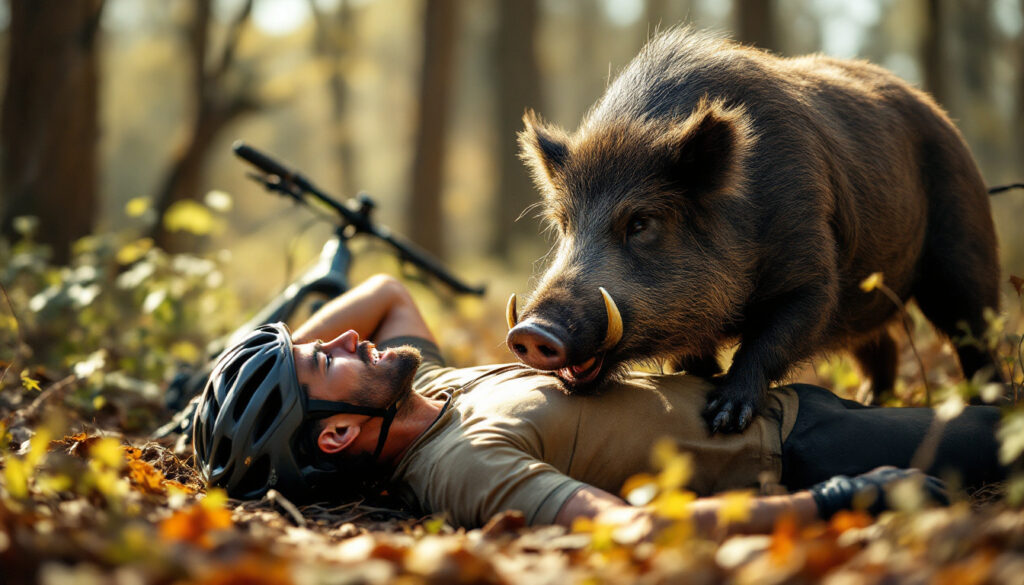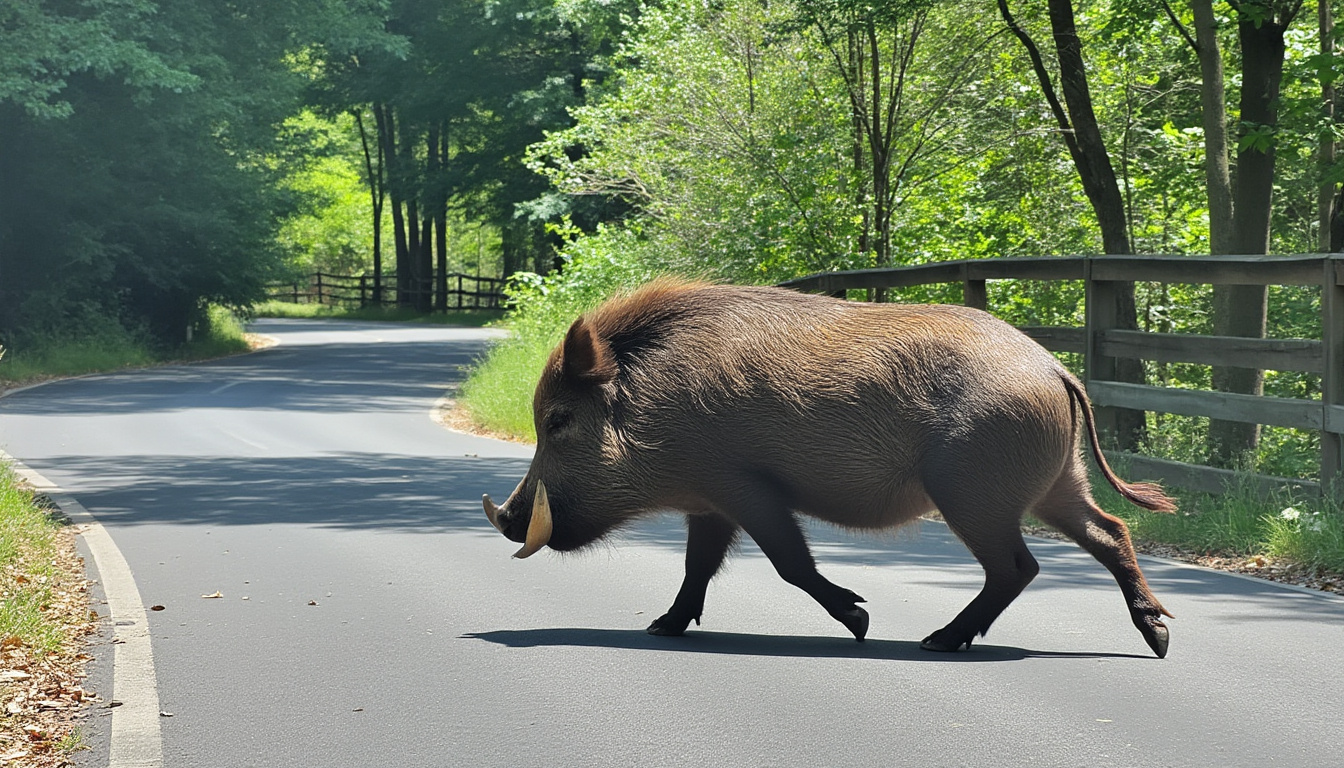A cyclist tragically died after a collision with a wild boar

A terrible road accident recently mourned the cycling community after a cyclist lost her life following a tragic collision with a wild boar. This drama underscores the importance of road safety, particularly for cyclists, who often find themselves in danger due to the unpredictability of nature as well as automobile traffic. Cycling, a beloved sport for many, must be practiced with the utmost attention and caution. This event has revealed safety issues, raised awareness, and highlighted the risks cyclists are exposed to, especially during their training on the roads. In this article, we will examine the circumstances of the accident, the challenges of road safety for cyclists, and preventive measures to consider.
The circumstances of the fatal accident
The tragedy occurred on the evening of April 25, 2025, on a road in Gironde, specifically on Avenue des Landes de Gascogne in Mios, near the Arcachon Basin. The victim, a 55-year-old woman, was riding her motorcycle on this road, which is generally little frequented but conducive to unexpected encounters with wildlife.
The firefighters, who arrived at the scene shortly after the accident, reported that the cyclist was surprised by a wild boar crossing the road. This situation represents an increasing risk on less busy routes, where encounters with wild animals are more likely to occur, often leading to dramatic consequences. The fatal accident in Mios is not an isolated event; it occurs shortly after two other fatal accidents that happened in just 48 hours in the same region. A 23-year-old man and another 22-year-old motorcyclist also lost their lives in similar circumstances, highlighting a worrying pattern of dangers faced by road users, particularly those on two wheels.
The impacts on the cycling community
These tragic events underscore major concerns within the cycling community and among local authorities. For many cyclists, the fear of such collisions rekindles worries about safety on the roads. An accident of this nature often leads to reflections on the existing safety measures. Indeed, it is crucial to consider the different types of protections that cyclists should contemplate to ensure their safety.
- Helmets: Wearing a helmet is an essential protective measure that can reduce the risk of serious injury in an accident.
- Reflective clothing: Wearing visibility gear can improve a cyclist's detection in low light conditions, especially at dawn or dusk.
- Lighting: Installing front and rear lighting systems on the bike is essential, especially for nighttime rides.
Furthermore, it is paramount that cyclists are trained to recognize potential hazards on the roads, including wildlife. Awareness of these issues could help decrease the number of similar accidents. Training on road safety for road users, including sessions on how to react when encountering a wild animal on the road, could help mitigate the risks involved.
| Type of risk | Recommended safety measures |
|---|---|
| Collisions with animals | Training in managing unforeseen situations |
| Reduced visibility | Wearing reflective clothing and using lighting |
| Accidents with other vehicles | Preparation for various types of accidents |

Road safety: issues and challenges for cyclists
Road safety is a central concern, especially for two-wheeled users like cyclists. In 2025, many initiatives have been implemented to improve road safety. However, accidents resulting from collisions with animals, such as in the tragic case of our cyclist, highlight the urgent need to rethink our safety strategies.
Cycling, while being a beneficial activity for health and the environment, must be conducted with caution. Here are some specific challenges faced by cyclists:
- Cohabitation with automobile traffic: Shared roads can create risky situations where cyclists are in danger from automobiles.
- Insufficient cycling infrastructure: In several regions, cycling paths are underdeveloped, forcing cyclists to ride on potentially dangerous roads.
- Driver awareness: Motorists are not always attentive to cyclists, which increases the risk of accidents.
To address these challenges, it is essential to raise awareness about road safety, not only for cyclists but also for motorists. Informing road users is a crucial step that could help reduce accidents on the road, and initiatives such as sharing recommendations on cycling equipment or good driving practices could be integrated into road education programs.
Preventive measures to avoid accidents with wildlife
In light of the increase in accidents involving wildlife, it is crucial to implement effective preventive measures. Encounters with animals such as wild boars, especially in areas like Gironde where they are abundant, pose a real risk for cyclists. To prevent such tragedies, several strategies can be considered.
Coordinated actions between local authorities and cycling associations can play a key role in accident prevention. Here are some suggestions:
- Securing traffic routes: Establish warning signs indicating the potential presence of wildlife on the roads. Informing road users would make them more vigilant.
- Creation of protected zones: Identifying and creating spacious zones where wildlife is particularly active could help prevent collisions.
- Aware programs: Organizing awareness campaigns on the dangers associated with wildlife for cyclists. This could include information sessions on what to do when encountering an animal on the road.
| Type of measure | Description |
|---|---|
| Warning signs | Warn drivers of the presence of animals on the road |
| Protected zones | Creation of dedicated spaces to preserve wildlife and avoid collisions |
| Aware programs | Inform cyclists on how to react when faced with animals on the road |
Cyclist equipment: a good investment for safety
Investing in good cyclist equipment is crucial for the safety of cyclists, especially in a context where accidents are becoming more frequent. Not only does the equipment contribute to better comfort, but it also provides indispensable protection during outdoor rides, both in urban or rural settings. Bicycle brands are increasingly focusing on integrating safety devices into their gear.
Essential items of cyclist equipment
Cyclist equipment should be chosen carefully to ensure optimal safety. Here’s a list of essential items:
- Helmet: Head protection is paramount. Modern helmets often integrate additional technologies to enhance safety.
- Protective clothing: Gloves and outerwear specially designed for cycling can also provide extra protection.
- Lighting systems: Plan for lamps both front and back of the bike to remain visible, especially in low light conditions.
- GPS and communication devices: Cyclists can use systems like intercoms to stay connected and receive real-time alerts.
Moreover, the trend of integrating new technologies into cycling equipment, such as advanced communication systems, offers significant safety advantages for cyclists when they ride in groups or through natural landscapes.
Raising awareness about road safety and wildlife
Special attention must be paid to raising awareness about road safety and wildlife to decrease the number of tragic accidents. Cyclists are not the only brave warriors of the roads; they must share the lanes with many other users, including animals. That is why discussions around road safety should include discussions about wildlife and the coexistence between nature and road traffic.
Awareness campaigns should focus on several axes:
- Train cyclists on potential dangers: This includes recognizing signs of wildlife, as well as knowing how to react when faced with an animal.
- Educate motorists: Raising driver awareness about the presence of cyclists and wild animals on the road is crucial for everyone’s safety.
- Promote community events: Organizing activities, group rides, and workshops around road safety and wildlife awareness can foster better coexistence on the roads.
It is imperative that cycling associations collaborate with authorities and conservation organizations to strengthen road safety. Indeed, a concerted approach could lead to more effective solutions to ensure the safety of all road users.
| Awareness theme | Objective |
|---|---|
| Training cyclists | Help better understand and anticipate road dangers |
| Educating motorists | Reduce the risk of accidents |
| Community activities | Reinforce collective awareness and coexistence on the roads |
Source: france3-regions.francetvinfo.fr
Leave a Reply



Articles relatifs